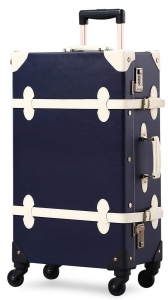The Travel Trunk
Before the invention of the suitcase wheel—before the “suit-case” was even invented—the travel trunk was the go-to companion for travelers of all kind. Businessmen and tourists alike had to rely on these large, unwieldy boxes to shield their possessions on their journeys.
Since steamboats were the primary method of international transportation in the 19th century, these travel trunks had to be able to withstand some rough rides. Crafted with bases of iron and wood, they could sometimes weigh over 100 pounds empty. Porters typically bore the brunt of this weight, transporting the cases to and from ships and carriages.
Birth of the “Suit-Case”
With leisurely travel becoming more commonplace in the late 19th century, a market for a more manageable trunk grew. Thus the “suit-case” was born, though it was still a fairly heavy piece of equipment. Its design evolved over the next few decades to become more lightweight and efficient, making it the default choice of baggage for most trips.
Still, by the mid-20th century, the suitcase wheel hadn’t yet hit the market. Luggage was usually hauled over short distances—to and from cars and trains, mostly. However, with airline travel becoming more popular, travelers had to carry their suitcases over greater distances across terminals. This wasn’t seen as issue initially—baggage transport had already improved significantly since the travel trunk days, and men were happy to showcase their strength by handling the family luggage.
Luggage Trolleys
To answer this problem, foldable luggage trolleys began to creep into travel shops in the 1960s. Now people who didn’t care for displays of machismo could simply strap their suitcases to a small rolling cart. These trolleys were especially helpful for the growing number of travelling women. However, this contraption wasn’t quite the suitcase wheel as we know it today. Though the trolley was convenient, it was still a bit cumbersome to travel with the extra equipment.
Inventing the Wheel
The suitcase wheel itself was first conceived in 1970 by Bernard Sadow, then vice president of the travel company US Luggage. He noticed that even with the increasing popularity of luggage trolleys, travelers were still having a tough time hauling their possessions around. In a moment of clarity, he had the idea to attach wheels directly to the bottom of a suitcase and slap on a strap for pulling. He succeeded in patenting his idea in 1972, though only two years later some of his competitors banded together and successfully repealed the patent.
With the suitcase wheel now open to the competitive market, suitcase manufacturers began to produce these new rolling suitcases. It wasn’t long before the new invention caught on, though there was still some hesitancy by some men to adopt the new contraption, not wanting to appear weak.
Reinventing the Wheel
In 1987, the suitcase wheel underwent another transformation with the invention of the Rollaboard. Robert Plath, an airline pilot at the time, crafted a suitcase with only two wheels—inline instead of spinning—and a telescoping handle up top. The contraption was readily received, and he started selling his suitcase to other pilots and flight attendants. A few years later, Plath started the company Travelpro International to manufacture and sell his suitcases to a broader market.
Samsonite ushered the return of the four-spinner-wheel designed in 2004, combining the once-ubiquitous technology with telescoping handles and lightweight bodies. This design was quickly adopted by other companies, and has since become one of the most popular suitcase designs.
Since 2004, the suitcase wheel has not undergone any major transformations. While the two-inline-wheel design is technically newer, the four-spinner-wheel design has had a roaring comeback. There are pros and cons on both sides of the inline vs. spinner wheel debate, but one thing is for certain: we’re glad someone decided to take the lug out of luggage.





